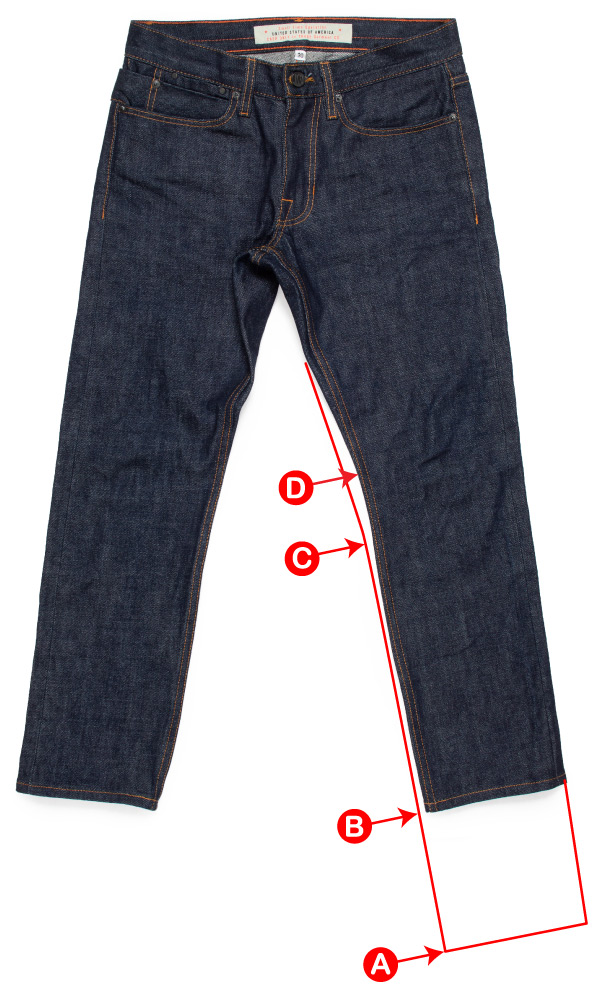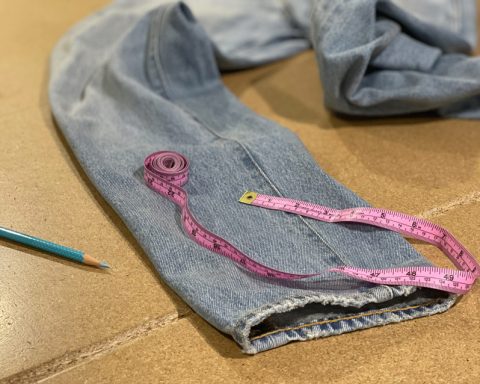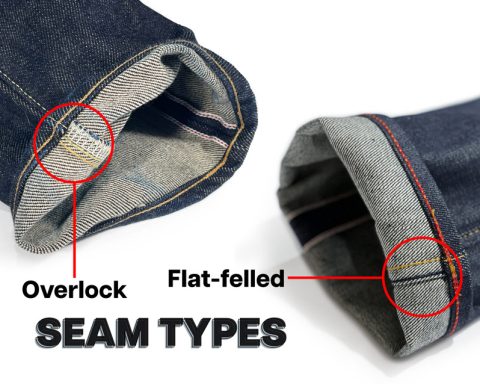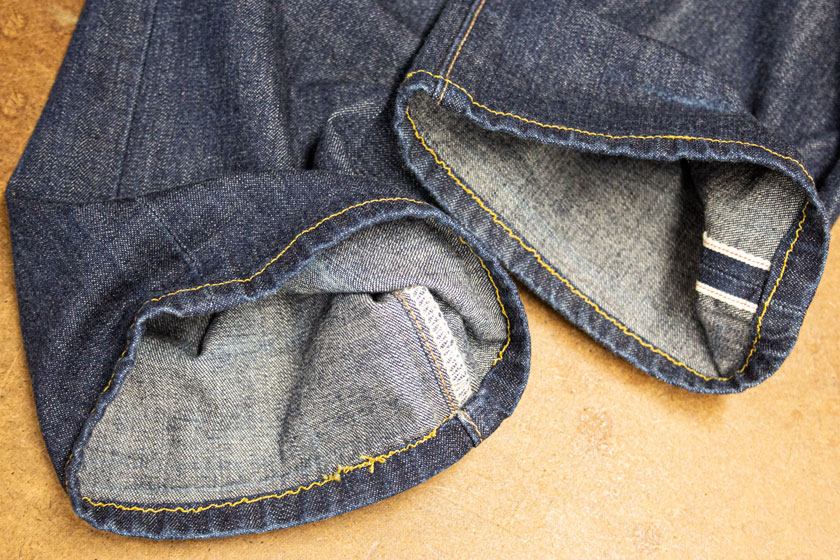
When smaller and mid-sized denim brands manufacture jeans, they try to cover a wide range of customers by producing jeans as long as 34 to 36 inches. For those who have to shorten jeans or pants offered by most better producers, we would like to share this example of how to hem a pair of jeans and achieve the original optimal fit through the leg shape.

- A – The leg opening is also known as the hem. The inseam of this jean originally measured 34-inches long.
- B – Hemming is shortening the inseam length. These jeans have been hemmed to measure 28-inches in length. The leg opening appears slightly smaller at this point in the photo, however, with added tapering, the hem has been trimmed to the original size. It is only because the width of a tapered pant gets larger the higher up you go. The raised leg opening looks smaller at this point as compared with the original width.
- C – This is the original knee position of the uncut 34-inseam leg (12 ½ ” below the crotch). The knee is where the leg circumference begins enlargement into the thigh. Without raising the knee position on shortened jeans, the area around the knee will be bigger than it was originally designed.
- D – By tapering, we trimmed the denim slightly to match the original measurements at the lower leg and raised the knee placement so the leg keeps its original contoured shape. The new knee is located 10 ½ ” below the crotch. Without raising the knee, you can see how much extra fabric would remain if hemming alone.
Unless you are up for laying out good money for a pair of custom-made jeans, it is likely a brand that offers multiple inseam options will simply make its standard size and cut the length down before shipping, without consideration of moving the knee position. Like most brands, if you order hemming without additional tapering, we would do the same.
Let’s say a brand offers pants or jeans sizes 30×28, 30×29, 30×30, and 30×31. That’s four different inseams within a single waist size. To have the proper knee location on each and every size would require four different sets of patterns. One pattern per waist size, per each inseam length. It is unlikely a brand would do so unless they are a mass producer. Now that you have an understanding of why it is so difficult to find pants off-the-shelf in a multitude of inseam sizes and the behind-the-curtain factors associated with those who may, let’s get to the workaround.
Our suggestion is merely hemming jeans and adding tapering. For this is a simple alteration where we take apart the legs, make the adjustments, then put them back together. If constructed with a lap or flat-felled seam with double stitch lines, we only need to take apart the inseam. If the jeans are constructed with a serger and single-needle stitch line at the inseam, we start by removing the inseam’s topstitching. Next, we draft the new shape at the inseam and sew it back together following the original thread colors. The outseam is never touched.

Before explaining how to hem jeans with added tapering, we will first explain the two types of construction found in most jeans. Inseam design is especially important when it comes to tapering but it does not matter for hemming.
- E – Denim and work clothing most often are produced with a flat-felled seam. It has a double-needle chain stitch (sometimes 3-needles in work pants) at the inseam for strength and durability. It would be surprising if your local cleaners, tailor, or even most denim specialists have the machine required to sew this seam. It is mainly found in factories and small-batch jeans makers. Without the need to open the outseam, it sews the topstitching and closes the seam in a single pass.
- F – Pictured in both images are selvedge (selvage) outseams. The vast amount of jeans sold will not be produced in selvedge denim. Top-end denim brands will offer selvedge in their line-ups. Some only offer selvedge. Selvedge does not factor in the quality of the fabric. When jeans are not produced in selvedge denim, the outseams can also be constructed with an overlocked edge and pressed open. Low-end denim producers routinely close the outseams with a closed overlock for speed.
- G – The hem or leg opening on jeans is commonly sewn with chain stitching in better denim. Low-end makers will frequently use a standard lock-stitch. Home sewers and fine tailors often run into difficulty working with the hem using sewing machines not suitable for sewing through multiple layers of denim fabric.
- H – Makers of very heavy jeans will construct them with a single-needle topstitched inseam to avoid the difficulties of folding and sewing through multiple layers of thick denim. On women’s and skinny jeans, single-needle topstitch construction is also most often used for comfort and flexibility. Lower-priced jeans also prefer the serger seam for ease and speed.
The heavy lifting in the leg shape of jeans is at the inseam. Selvedge and a good deal of non-selvedge jeans have a straight outseam from the hem-to-hip curve. Unless the jeans have a flared or bootcut, tapering should be done at the inseam. Tapering selvedge from the outseam would be unforgivable.
Even though outseam tapering alterations and regular lockstitch stitched hems are simply amateur, there are commercially produced YouTube videos where one of the world’s biggest and most popular denim brands gets it wrong. Perhaps because it’s faster, more convenient or they don’t have the right equipment and skilled operators in their stores for factory quality alterations. Good advice before letting anyone begin work on your jeans – ask how they intend to do it.









